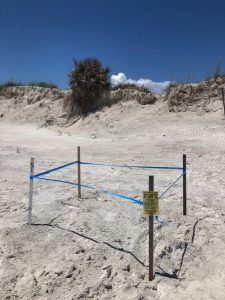 Sea turtle nesting season in Flagler and Volusia Counties spans from May 1 to October 31. As we start to see more nests marked off on the beach, your best bet will be that they belong to a loggerhead sea turtle. Florida is the epicenter of loggerhead nesting grounds and loggerheads are the most common species in our state. Last year Flagler County beaches saw 1,008 loggerhead nests, followed by 243 green turtles and 8 leatherback nests. Volusia county, with a longer coastline, hosted 4,626 loggerhead nests, 2,831 green turtle nests, and 23 leatherback nests. You can find more information about these three species of sea turtles in the table at the end of this blog post.
Sea turtle nesting season in Flagler and Volusia Counties spans from May 1 to October 31. As we start to see more nests marked off on the beach, your best bet will be that they belong to a loggerhead sea turtle. Florida is the epicenter of loggerhead nesting grounds and loggerheads are the most common species in our state. Last year Flagler County beaches saw 1,008 loggerhead nests, followed by 243 green turtles and 8 leatherback nests. Volusia county, with a longer coastline, hosted 4,626 loggerhead nests, 2,831 green turtle nests, and 23 leatherback nests. You can find more information about these three species of sea turtles in the table at the end of this blog post.
These nests were located by the hard-working volunteers at multiple organizations, as well as national park staff. The Volusia/Flagler Turtle Patrol survey the coastline of Flagler County and Volusia County north of Ponce Inlet each morning looking for turtle tracks and nests. Volunteers collect information about the nest to provide to the FWC and mark the nest so that it can be monitored and to prevent visitors to the beach from accidentally disturbing it. Down in New Smyrna Beach, the NSB Turtle Trackers do the same surveys, data recording, and monitoring of nests throughout the season. The most southern portion of Volusia County beaches lie within the Canaveral National Seashore, where the park rangers survey the nests.
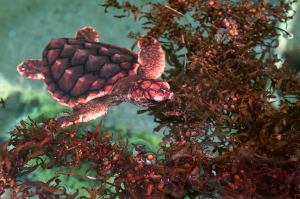
Later this summer, approximately two months after a nest is laid, around 100 hatchings will emerge from a nest at night and head out to sea, following the reflection of the moon. These tiny turtles must make it past many hungry predators on the beach and at sea until they can reach a natural refuge, the floating mats of the sargassum seaweed. Due to a combination of natural and human-related threats, sea turtle hatchlings only have an estimated 1 in 1,000 chance of survival to adulthood!
There are many more threats that sea turtles face throughout their life cycle that can affect the populations as a whole. Thankfully there are also actions we can take to ensure females are able to safely nest without disturbance and that their hatchlings have the highest chance of survival possible!
Threats to sea turtles, and what we can do to help protect them
Threat: Human disturbance
Such as physical obstacles, artificial lighting or activity on the beaches at night
What we can do:
Help keep the beach free of obstacles by filling in any holes and flattening out sandcastles after a day at the beach with the family and be sure to remove all beach toys and furniture at night. This ensures mothers and babies can safely travel across the beach.
Don’t use white lights on the beaches at night and if you come across a nesting turtle give her space, as a disturbed mother may leave the beach without laying eggs. If you walk on the beach at night, use a red LED light rather than a white light. Keeping lights off at the beaches continues to be important when the babies begin to hatch, so that they do not get disoriented and travel in the wrong direction. If you live near the beach, check out this beachfront lighting information to ensure your lights are not affecting nesting or hatching sea turtles.
Threat: Habitat loss
Due to development and coastal erosion decreases nesting areas.
What we can do:
Support local, state, and national parks that provide natural areas for sea turtles to nest. Protect the sand dunes by using designated walkways and not walking through the dunes.
Threat: Plastic pollution
Plastic waste that makes it into the ocean becomes covered in small marine organisms and can then smell and look like food to sea turtles. Over 50% of sea turtles worldwide are believed to have eaten plastic, which can lead to health issues and starvation. Turtles can also become entangled in discarded fishing gear.
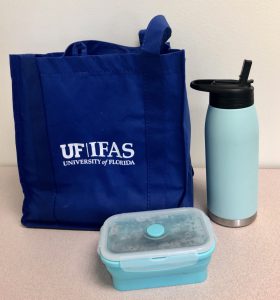
What we can do:
Take all of your trash with you and pick up trash on the beach you see on the beach. Dispose of fishing line properly (look for the fishing line recycling tube at your nearest fishing dock!). Reduce your use of single-use plastics by building habits of carrying a reusable water bottle and shopping bags with you on a daily basis. Support companies that provide alternatives to plastic and initiatives to reduce single-use plastic in your community.
Threat: A changing climate
Warmer temperatures may affect the sex ratios of sea turtle populations, as the temperature of the nest determines if sea turtles develop as males or females. In the long term this could affect sea turtle reproduction and population size. Sea level rise and an increase in the number of intense hurricanes due to a changing climate can flood or wash away nests and decrease the amount of suitable nesting beach area.
What we can do:
Reduce our use of fossil fuels such as oil and gas. We can do this by both reducing our overall energy use and by utilizing renewable sources of energy. This is a big undertaking that we need to tackle as a community. Thankfully, innovations in technology are making alternative energy more accessible, and some energy companies will let you choose to use renewable energy sources for your home. Another important step we can all take it to make sure we understand the science of climate change and discuss it with our family and friends so that it becomes a less taboo and politicized topic.
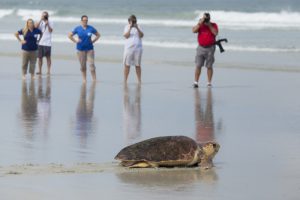
What should I do if I see a sea turtle on the beach?
If you see sea turtles nesting or hatching, enjoy their beauty with plenty of space between you and the turtles and do not touch them. If you think they are injured or there are hatchings that ended up in the wrong place, notify the local Beach Safety officer or Call Florida Fish and Wildlife 888-404-3922
Good news for sea turtles!
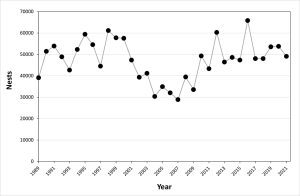
The Fish and Wildlife Research Institute’s Index Nesting Beach Survey documented an increase in nests of all three sea turtle species since it started in 1989. This survey focuses on specific beaches to provide consistent data over years and documents the number of nests as an indicator of the population size. Loggerhead nests have only increased slightly since 1989, but they were already at a higher population to start. In comparison, green turtle nests have increased 80x and leatherback nests have increased dramatically as well.
This is great news, demonstrating the actions we have taken to protect sea turtles through changes in fishing gear, international agreements prohibiting the trade of sea turtle products and eggs, and protection and monitoring of nests and nesting beaches have been working! While population have made great improvements in recent decades, they are still at a fraction of their original population size. Therefore, it is important that we continue to educate residents and visitors to beaches of the role they play in sea turtle survival so that these trends continue in a positive direction!
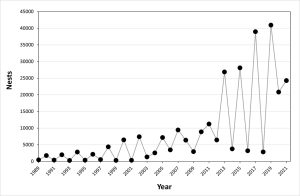

The 2022 nesting season broke records for nests in both Flagler and Volusia Counties! Does that mean we will expect to see even more this year?
We had a great nesting season last year, even with some nests lost to the fall hurricanes. However, high nest numbers one year do not necessarily mean high numbers the nest. Female sea turtles only nest every 2-4 years, meaning females who nested last year did not nest this year, and those that nested this year won’t return for another couple of years. Therefore, it will be important to look at the trends over several years rather than one exceptionally high or low year.
Nest numbers increased statewide – this is great news demonstrating that policy changes put in place to protect sea turtles, the work of volunteers monitoring nests, and efforts to rehabilitate injured turtles are all paying off. Overall, the number of nests in Flagler and Volusia Counties increased at a higher rate than the rest of the state. Our exceptionally high increase here may be due to a shift northward with warming temperatures or as southern beaches become more crowded (with people and turtles!), and we may continue to see increased numbers of sea turtle nests.
However, our beaches also took a hit from Hurricane Ian in the fall of 2022, which could affect the amount of suitable nesting habitat this season. Female sea turtles nest at the upper edge of the beach at the base of the sand dunes, where their nests will remain safe from inundation at high tide. Many of our dunes were eroded and there are sections where high tide waves come all the way up the beach. Some areas have begun to sea sand accrete, while others still have a small beach area and steep drop off. It is more important than ever to protect our remaining sand dunes and the vegetation living on them, and we will have to watch the nesting trends over the next several years to see what effects the loss of beach holds for the turtles.
Would you like to see a sea turtle in person or get involved as a volunteer?
We have several organizations in both Flagler and Volusia Counties that you can check out!

Volusia:
- Canaveral National Seashore provides a rare opportunity to see a sea turtle nesting through its Turtle Watch programs select nights during the nesting season. Reservations for June will be available starting May 15. Call (386) 428-3384 ext. 248 to make a reservation.
- The Marine Science Center in Ponce Inlet is a great place to learn about sea turtles and see the patients in their rehabilitation center.
- Support the NSB Turtle Trackers or the Volusia/Flagler Turtle Patrol by “adopting a nest” or volunteering as a surveyor or at beach cleanups.
- Volusia county has many resources with information for you, including my favorite, the nesting summary.
Flagler:
- Volunteer as a surveyor or “adopt a nest” with the Volusia/Flagler Turtle Patrol.
- The Sea Turtle Hospital at the UF Whitney Lab is home to a rehabilitation facility and research on Fibropapilloma virus. Visit the website for information on how to volunteer and keep an eye out for educational opportunities.
- Marineland houses several sea turtles that could not be released to the wild following injury and can be viewed by the public.
Sea turtle curriculum available:
If you work in education, have kids in the home, or are just a kid at heart, I recommend the 5th grade sea turtle curriculum created by Dr. Maia McGuire of Sea Grant and UF/IFAS Extension. There are ten lesson plans available, as well as the PDF of the book One in a Thousand: Those Amazing Sea Turtles.
Summary of information on our most common sea turtle species
| Common name | Loggerhead | Green | Leatherback |
| Scientific name | Caretta caretta | Chelonia mydas | Dermochelys coriacea |
| Volusia nests in 2022 | 4,626 | 2,831 | 23 |
| Flagler nests in 2022 | 1,008 | 243 | 8 |
| Nests all of FL 2022 | 116,765 | 37,028 | 1,848 |
| Status | Threatened | Threatened | Endangered |
| Carapace length | 2.5-3.5 feet | 3-4 feet | 4-6 feet |
| Weight | 150-375 lbs | 240-420 lbs | 660-1,100 lbs
(biggest was 2,000!) |
| What they eat | Shellfish (horseshoe crabs, clams, mussels) | Seagrass and algae | Jellyfish |
| Where they live | Shallow water along the continental shelf; bays and estuaries | Bays and protected shores | Open ocean, worldwide |
| Nesting in Florida | Nest April-September
Nest every 2-4 years 3-6 nests per season 100-125 eggs per nest 60 days incubation |
Nest June-September
Nest every 2 years 3-5 nests per season 115 eggs per nest 60 days incubation |
Nest April-July
Nest every 2-3 years 4-7 times per season 80 fertilized eggs 65 day incubation |
| Threats to survival | Loss of nesting habitat, predation of nests, human disturbances | Commercial harvest for eggs and food | Marine pollution, incidental take in fisheries |
| Population estimate of nesting females worldwide in 2004 | 40,000-50,000 | 85,000-95,000 | 34,000-36,000 |
Sources:
https://myfwc.com/research/wildlife/sea-turtles/nesting/statewide/
 1
1
